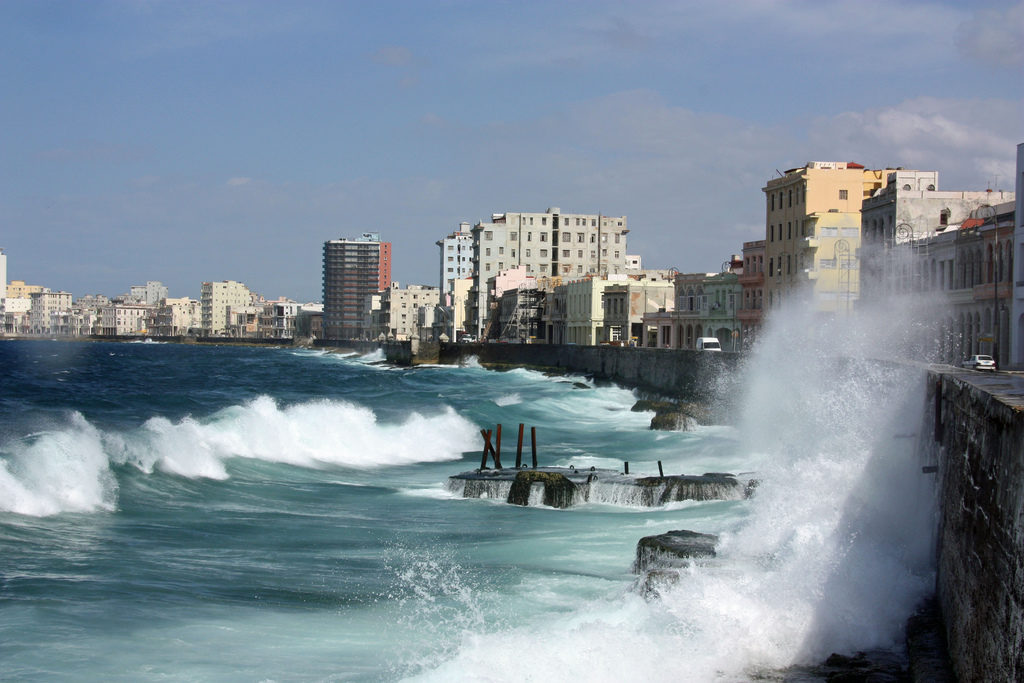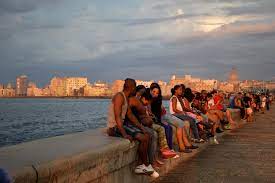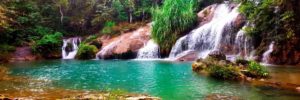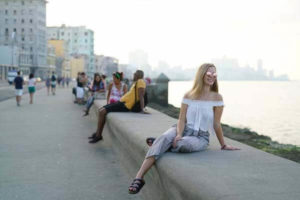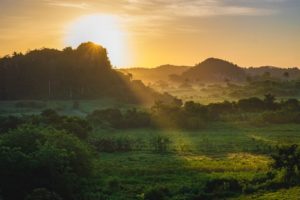THE POPULAR AND HISTORIC HAVANA’S MALECÓN: CUBA’S MOST FAMOUS SEASIDE AVENUE. PHOTOS/VIDEOS
The Havana Malecón, first named Avenida del Golfo, is Cuba’s most famous sea-side avenue, are a broad esplanade, roadway, and seawall that stretches for 8 km (5 miles) along the coast in Havana, Cuba, from the mouth of Havana Harbor in Old Havana, along the north side of the Centro Habana neighborhood and the Vedado neighborhood, ending at the mouth of the Almendares River. New businesses are appearing on the esplanade due to economic reforms in Cuba that now allow Cubans to own private businesses.
HISTORY
The project was undertaken by Don Francisco de Albear, Cuba’s greatest engineer at the time. Albear came up with a complex but smart design for the seawall, which was to be a lot more than just a promenade. According to historical records, the avenue was supposed to be constructed 4 meters above sea level. The whole project would cost 850,000 pesos, but the Spanish government didn’t bring itself to issue the construction permit and Albear’s proposal was postponed.
But the construction of the Malecón began in 1901, during temporary U.S. military rule. The main purpose of building the Malecón was to protect Havana from the sea and the so-called American Nortes.
To celebrate the construction of the first 500m section of the Malecón, the American government built a roundabout at the intersection of Paseo del Prado, which, according to architects of the period, was the first one built in Cuba with steel-reinforced concrete. In front of the roundabout, where every Sunday bands played Cuban melodies, the Miramar Hotel was built, which was very much in fashion for the first 15 years of independence, and which was the first one where the waiters wore tuxedos (dinner jackets) and vests (waistcoats) with gold buttons.
Subsequent Cuban governments continued the extension of the first section of the Malecón. In 1923, it reached the mouth of the Almendares River between K and L streets in Vedado, where the United States Embassy was built, near the José Martí Sports Park and, further out, the Hotel Rosita de Hornedo (today, the Sierra Maestra).
In 1957 and 1958, the roadway served as the venue of the Cuban Grand Prix.
STAGES OF COMPLETION
From the start in 1901 and 1902, from the Paseo del Prado to Calle Crespo.
Between 1902 and 1921 as far as the Monument to the Victims of the USS Maine.
Between 1948 and 1952 to the mouth of the Almendares River.
TODAY MALECON
The Malecón continues to be popular among Cubans.
It is also a means of income for poorer families as individual fishermen cast their lures there. In addition, it is a hotspot for prostitution in Cuba by men and women.
Although the houses lining the Malecón are mostly in ruins, the Malecón remains one of the most spectacular and popular destinations in Havana.
But beyond the architectural values of the buildings, its greatest charm lies in being somewhere to stroll or hang out on a stiflingly hot day. It is a place where couples come to make amends, especially at sunset, in the company of children and fishermen. It is Havana’s outdoor lounge.
POINTS OF INTEREST
There are a number of important monuments along the Malecón, including those to General Máximo Gomez, Antonio Maceo, General Calixto García, and the Monument to the Victims of the USS Maine.
At the intersection of 23rd Street, the Malecón marks the northeast end of the La Rampa section of 23rd Street, Vedado.
In the Plaza de la Dignidad is a statue of José Martí and in front of the Embassy of the United States, the so-called José Martí Anti-Imperialist Platform.
Significant buildings include the Castillo de la Real Fuerza, the Castillo de San Salvador de la Punta, Malecón 17 (Las Cariátides) and the Hotel Nacional.
There were several buildings, monuments, and geographical features that were a part of Barrio de San Lázaro including the Torreón de San Lázaro, La Casa de Beneficencia, Hospital de San Lázaro, exthe Espada Cemetery, the Casa de Dementes de San Dionisio, the Quarry of San Lázaro, the Batería de la Reina, the Santa Clara Battery, and Hill of Taganana, among others.
IN POPULAR CULTURE
The Malecón has served as an inspiration for several cocktail names, including the “Malecón cocktail” by John Escalante that can be traced back to his 1915 Cuban cocktail guide, Manual Del Cantinero.
EL HISTORICO Y POPULAR MALECÓN DE LA HABANA, LA AVENIDA MARÍTIMA MÁS FAMOSA DE CUBA. FOTOS Y VIDEOS
El Malecón de La Habana, primero llamado Avenida del Golfo, es la avenida costera más famosa de Cuba, es una amplia explanada, camino y malecón que se extiende por 8 km (5 millas) a lo largo de la costa en La Habana, Cuba, desde la desembocadura de La Habana. Puerto en La Habana Vieja, a lo largo del lado norte del barrio Centro Habana y del Vedado, terminando en la desembocadura del río Almendares. Están apareciendo nuevos negocios en la explanada debido a las reformas económicas en Cuba que ahora permiten a los cubanos poseer negocios privados.
HISTORIA
El proyecto fue realizado por Don Francisco de Albear, el ingeniero más grande de Cuba en ese momento. A Albear se le ocurrió un diseño complejo pero inteligente para el malecón, que iba a ser mucho más que un simple paseo. Según los registros históricos, se suponía que la avenida se construiría a 4 metros sobre el nivel del mar. Todo el proyecto costaría 850.000 pesos, pero el gobierno español no se atrevió a emitir el permiso de construcción y la propuesta de Albear se pospuso.
Pero la construcción del Malecón comenzó en 1901, durante el régimen militar temporal de Estados Unidos. El objetivo principal de la construcción del Malecón era proteger a La Habana del mar y los llamados Nortes americanos.
 VIDEOS- EL MALECON DE LA HABANA…
VIDEOS- EL MALECON DE LA HABANA…
Para celebrar la construcción del primer tramo de 500m del Malecón, el gobierno estadounidense construyó una rotonda en el cruce del Paseo del Prado, que, según los arquitectos de la época, fue la primera construida en Cuba con hormigón armado. Frente a la rotonda, donde todos los domingos tocaban bandas de música cubana, se construyó el Hotel Miramar, que estuvo muy de moda durante los primeros 15 años de independencia, y que fue el primero donde los camareros vestían esmoquin y chalecos (chalecos) con botones dorados.
Los gobiernos cubanos posteriores continuaron la ampliación del primer tramo del Malecón. En 1923 llegó a la desembocadura del río Almendares entre las calles K y L del Vedado, donde se construyó la Embajada de los Estados Unidos, cerca del Parque Deportivo José Martí y, más lejos, el Hotel Rosita de Hornedo (hoy Sierra Maestra). .
En 1957 y 1958, la calzada sirvió como sede del Gran Premio de Cuba.
ETAPAS DE FINALIZACIÓN
Desde el inicio en 1901 y 1902, desde el Paseo del Prado hasta la Calle Crespo.
Entre 1902 y 1921 hasta el Monumento a las Víctimas del USS Maine.
Entre 1948 y 1952 hasta la desembocadura del río Almendares.
HOY MALECON
El Malecón sigue siendo popular entre los cubanos.
También es un medio de ingresos para las familias más pobres, ya que los pescadores individuales arrojan sus señuelos allí. Además, es un punto de acceso para la prostitución en Cuba por parte de hombres y mujeres.
Aunque las casas que bordean el Malecón están en su mayoría en ruinas, el Malecón sigue siendo uno de los destinos más espectaculares y populares de La Habana.
Pero más allá de los valores arquitectónicos de los edificios, su mayor encanto reside en estar en un lugar para pasear o pasar el rato en un día sofocante y caluroso. Es un lugar donde las parejas acuden a hacer las paces, sobre todo al atardecer, en compañía de niños y pescadores. Es el salón al aire libre de La Habana.
PUNTOS DE INTERÉS
Hay varios monumentos importantes a lo largo del Malecón, incluidos los del General Máximo Gómez, Antonio Maceo, el General Calixto García y el Monumento a las Víctimas del USS Maine.
En la intersección de la calle 23, el Malecón marca el extremo noreste de la sección La Rampa de la calle 23, Vedado.
En la Plaza de la Dignidad se encuentra una estatua de José Martí y frente a la Embajada de Estados Unidos, la denominada Plataforma Antiimperialista José Martí.
Entre los edificios importantes se encuentran el Castillo de la Real Fuerza, el Castillo de San Salvador de la Punta, el Malecón 17 (Las Cariátides) y el Hotel Nacional.
Había varios edificios, monumentos y accidentes geográficos que formaban parte del Barrio de San Lázaro como el Torreón de San Lázaro, La Casa de Beneficencia, Hospital de San Lázaro, ex el Cementerio de Espada, la Casa de Dementes de San Dionisio, la Cantera de San Lázaro, la Batería de la Reina, la Batería Santa Clara, y Cerro de Taganana, entre otros.
EN LA CULTURA POPULAR
El Malecón ha servido de inspiración para varios nombres de cócteles, incluido el “Cóctel Malecón” de John Escalante que se remonta a su guía de cócteles cubanos de 1915, Manual Del Cantinero.
Agencies/ Wiki/ HavanaMalecón/ Internet Photos/ YouTube/ Arnoldo Varona/ www.TheCubanHistory.com
THE CUBAN HISTORY, HOLLYWOOD.



